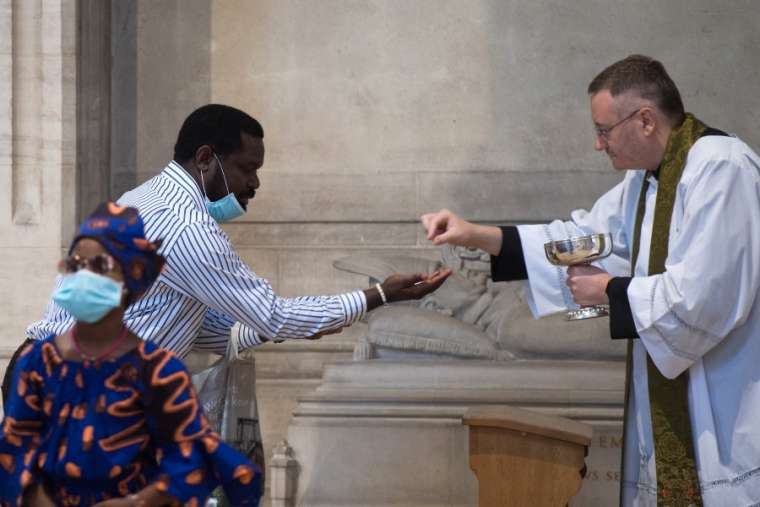The first public Mass since March takes place at St George’s Cathedral, Southwark, England, July 5, 2020. Credit: Mazur/cbcew.org.uk.
When the government permitted churches in England to resume public Masses July 4, Fr. Rick McGrath faced a difficult dilemma.
The Parish Priest of St. Wilfrid’s, Burgess Hill, in the county of West Sussex, realised that in order to comply with social distancing requirements, numbers at weekend Masses would be severely limited. He decided that rather than turn people away, he would only offer public Masses on weekdays.
“It was just a judgment call because I couldn’t bear the idea of shutting the doors in the face of people,” he told CNA.
Fr. McGrath, a native of Minnesota, explained that normally more than 400 people attend Mass on a Saturday evening and Sunday at St. Wilfrid’s, one of four locations where Mass is celebrated within the parish. But under the strict new regulations to prevent the spread of coronavirus, only 50-60 people would be permitted to attend each of the weekend Masses.
While other parishes introduced online booking systems, Fr. McGrath felt that would discriminate against older parishioners with limited internet access.
“I just couldn’t see any fair way of doing it,” he said. “The secretary is overworked already and doesn’t have time to be fielding phone calls and checking lists to see if you were there last week and therefore can’t come this week.”
“So I made the decision that we would try to provide daily Masses Monday through Saturday. A total of about 16, I think, we will have at various places during the week, but then have no Saturday evening or Sunday Masses at all until the situation has clarified itself.”
Fr. McGrath is not alone: other priests are struggling to resume public Masses, particularly in smaller churches away from England’s big cities.
It is difficult to assess the scale of the problem: there are no centrally collected statistics showing how many of the country’s Catholic churches have reopened for public Masses.
A spokesman for the Bishops’ Conference of England and Wales told CNA: “The decision on which parishes to open and which to remain closed for public worship is down to each diocese. Each bishop will make his own decision, largely based on size, geographical spread, among other local reasons.”
The bishops’ conference has issued detailed guidance on the resumption of public Masses, in line with principles set out by the government. Mass-goers must stand more than three feet apart and wear face coverings. Parishes are required to post a sign at the church door indicating “maximum safe operating capacity.”
Church authorities emphasize that the restrictions are necessary in order to prevent outbreaks of COVID-19, which has claimed the lives of 44,735 people in the U.K. as of July 11, according to the Johns Hopkins Coronavirus Resource Center — the third highest recorded figure in the world after those of the United States and Brazil.
But while the national picture is unclear, one English diocese has offered a glimpse of how churches are faring following the easing of lockdown rules.
“More than a third of the churches in the diocese have opened for Mass and about three quarters of them are open for prayer,” a spokesman for the Diocese of Shrewsbury, in western England, told CNA.
Fr. Alexander Lucie-Smith, pastor of St. Peter’s, Hove, a seaside town in East Sussex, has resumed public Sunday Masses. But he said that he understood why other parishes were unable to.
“One of the things that made the guidelines very hard to activate was the fact that you have to have two stewards on duty at any one time and neither of them can be over 70. Now, most of our volunteers are over 70,” he told CNA.
“We were very lucky in our church because we have quite a lot of people on furlough who volunteered to do it. But those people on furlough are now going back to work. As a result, it’s getting harder to find people to do it. Our church used to be open from dawn to dusk and now it can’t be.”
“But it’s quite understandable that quite a few churches didn’t have anybody to do this work for them.”
Lucie-Smith said that his parish had not been obliged to turn anyone away from its weekend Masses.
“At our place, we’re taking a strict interpretation of the rules,” he said. “We are allowing 100 people in. We did not get anywhere like 100 people for any of the Masses. In fact, over four Masses we got 120 people. So we’ve not had people queuing outside the door.”
Fr. McGrath said he was monitoring the situation to see whether the regulations will change. He is also in discussion with priests in neighbouring parishes.
“I know some people have started Sunday Mass with a ticketing system or to just shut the door after the number is in. And fair enough: there’s nothing wrong with that,” he said.
“But I do know a few priests who are doing as I am — that is, having a daily Mass and not the Sunday Mass, pretty much for the same reasons.”

